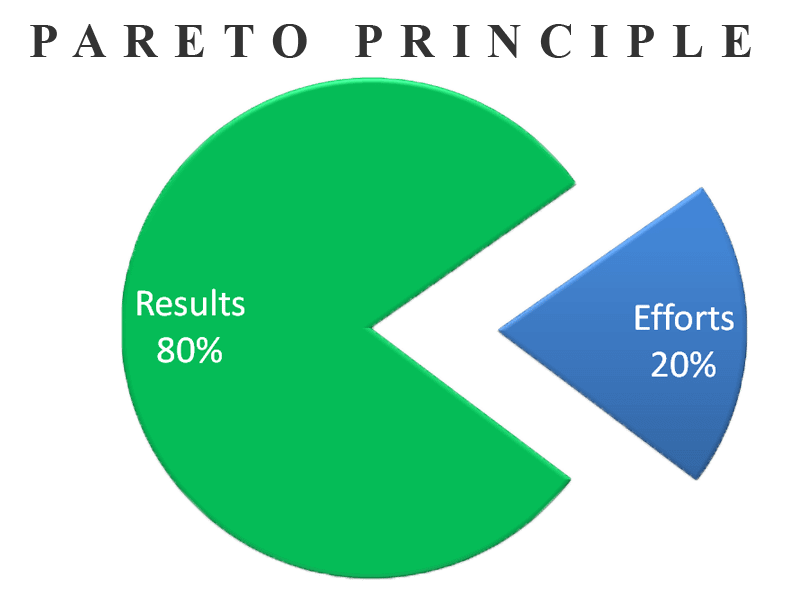
14 Sep Pareto Principle
One of the most constructive notion for Life’s efficiency and productivity is the Pareto principle.
Also known as the 80/20 rule, the law of the vital few, or the principle of factor sparsity, this rule states that for many events, roughly 80% of the effects come from 20% of the causes. Put differently, 20 percent of your activities will account for 80 percent of your results.
The principle was resurgented by Joseph M. Juran who named it after Italian economist Vilfredo Pareto. Pareto observed the 80/20 interrelation while at the University of Lausanne in 1896, as produced in his maiden work, Cours d’économie politique. It was popularized by reports that he perceived that 80% of the wholesome pea pods was occasioned by 20% of the pea plants. This resulted to him thinking about even distribution. He thought further about Non-current assets and came to the know that 20% of the citizenry owns about 80% of land in Italy. He investigated different sectors and found that 80% of production typically came from just 20% of the companies. The generalization became: 80% of results will come only from 20% action.
How Does The Pareto Principle Work?
The law of Vital Few is a conception that shows twenty percent, on any general to-do list, will turn out to be worth more than the other eighty percent put together. This “truism” about the disequilibrium of inputs and outputs is often seen in various chain of events:
- It is a precept of business that “80% of sales come from 20% of clients”.
- 20% of consumers account for 80% of total revenue.
- 20% of patients account for 80% of healthcare expenditure (and 5% of patients account for a full 50% of all disburse)
On a more personal note, one might be able to relate to this unintended 80/20 mannerism.
- Anthony owns at least five splufic suits, but 80% of the time or more he grabs his ash, well-styled, single-breasted Gucci with a white shirt. (Ladies, how many shoes do you own, and how often do you grab the same 20 %?)
- Funmi has 15 rooms in her house, but she spends about 80% of her time in just her bedroom, family room, and kitchen (exactly 20%).
- On my smartphone, I have 30 different mobile apps pinned to the tiles, but 80% of the time I’m only using the six on my home screen.
A study into the productivity principle of dynamos, go- getters, distinction students and even athletes resulted that they don’t manage all the assignments that gets their way. They use the Factor Sparsity principle to regulate what is of vital importance. Then, they delegate the rest, or simply let it go.
How You Can Use It
The key to success is to find the 20% of the activities in your spheres that will have the most significant impact on your successful outcome. Focus on the most important success factor. i.e. the key driver of success in your domain.
So how can you apply Pareto’s principle to produce significant overall meteoric success in your life?
- You work in the banking sector:- The primary factor of success is an understanding of finance and marketing. Don’t succeed at operations without understanding finance and marketing
- You work in tech:- The key factors are market awareness and ‘design thinking’. Don’t succeed at coding without developing basic awareness of market dynamics and design thinking.
- You in architecture:- The major factor is storytelling. Don’t be the good architect who can’t paint a picture with words and images to release client budget.
- You work in advertising:- The main factors are strategic thinking and client sensibility. Don’t be the great copywriter who can’t be trusted with client meetings.
- You are a CEO:- The principal factors are profitability and board management. Don’t chase other metrics.
80:20 rule- What is the 20% that will release 80% of your results?







No Comments